IBU5HRM Semester 1 2021: 'No Name' Airlines HRM Case Study Analysis
VerifiedAdded on 2021/09/30
|9
|3767
|68
Case Study
AI Summary
This case study examines the human resource management (HRM) practices of 'No Name' Airlines, a global company facing challenges in diversity management, performance appraisal, and training and development. The analysis delves into the company's shortcomings in fostering a diverse and inclusive workplace, particularly addressing generational gaps and communication breakdowns. It explores the significance of international performance management and the absence of structured evaluation mechanisms for expatriates. The study highlights the importance of training and development in enhancing employee skills and organizational success, while also emphasizing the impact of effective communication and employee engagement. Recommendations are provided to improve diversity management, implement performance-based assessments, and create comprehensive training programs to drive the company forward.
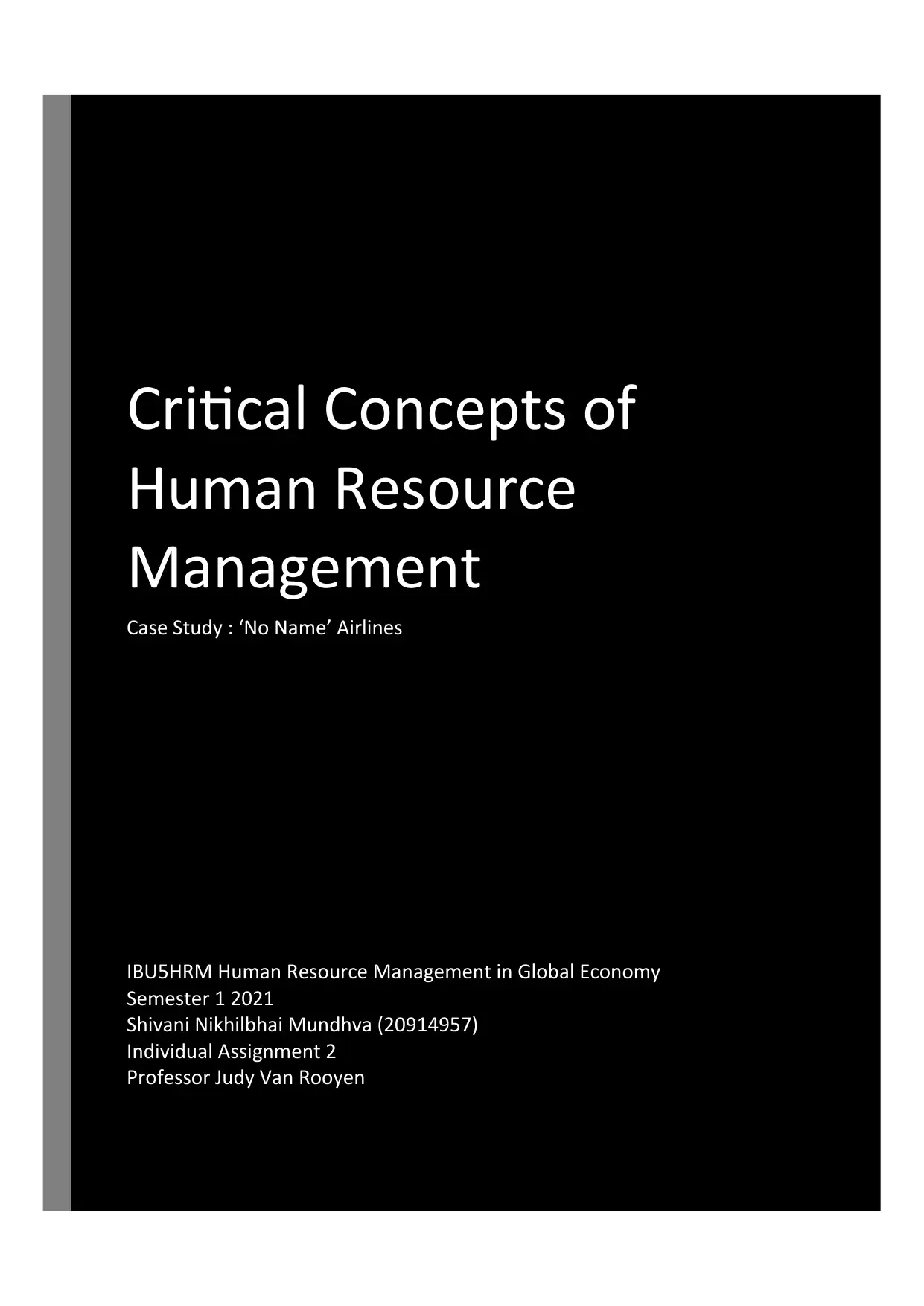
Critical Concepts of
Human Resource
Management
Case Study : ‘No Name’ Airlines
IBU5HRM Human Resource Management in Global Economy
Semester 1 2021
Shivani Nikhilbhai Mundhva (20914957)
Individual Assignment 2
Professor Judy Van Rooyen
Human Resource
Management
Case Study : ‘No Name’ Airlines
IBU5HRM Human Resource Management in Global Economy
Semester 1 2021
Shivani Nikhilbhai Mundhva (20914957)
Individual Assignment 2
Professor Judy Van Rooyen
Paraphrase This Document
Need a fresh take? Get an instant paraphrase of this document with our AI Paraphraser
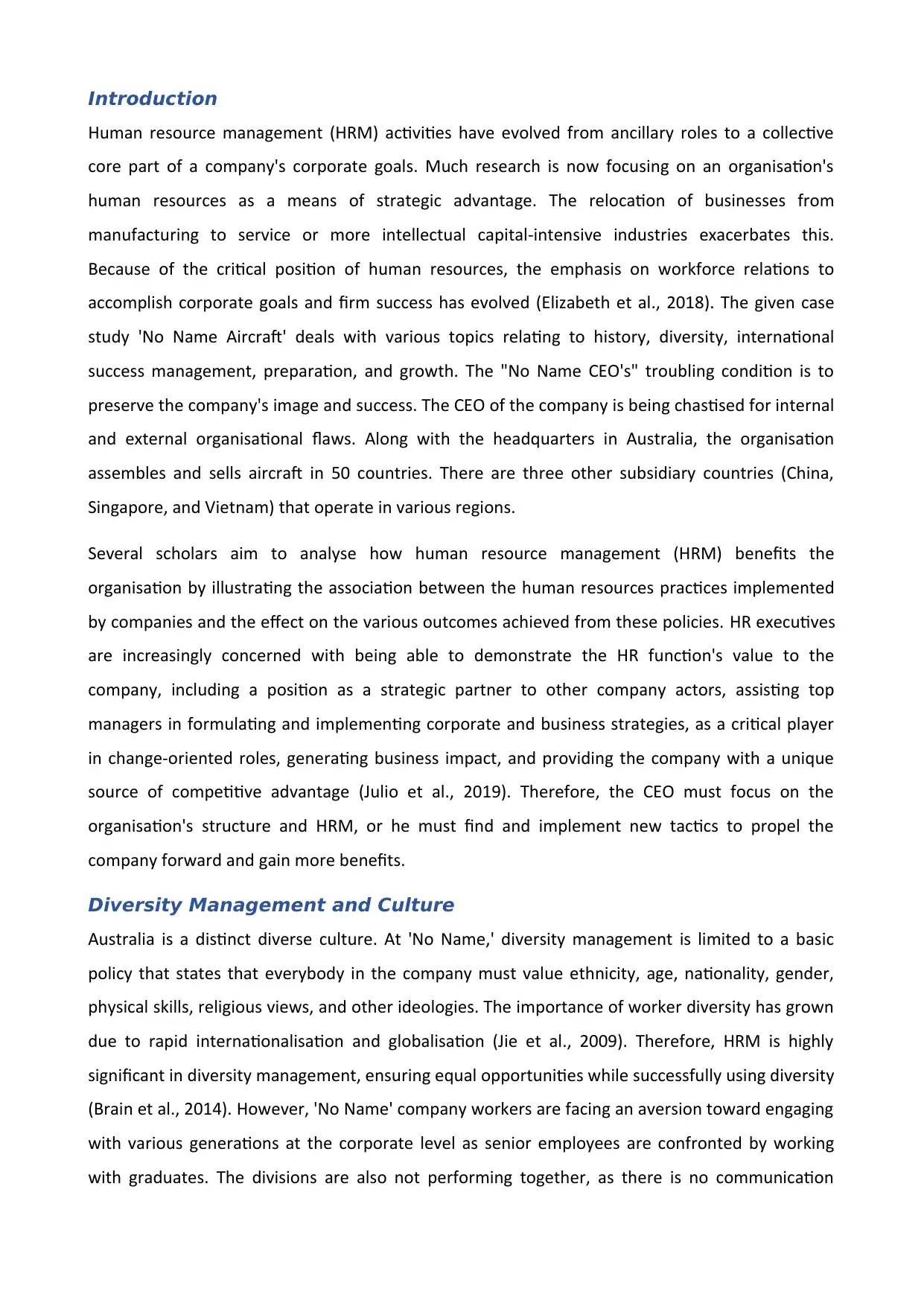
Introduction
Human resource management (HRM) activities have evolved from ancillary roles to a collective
core part of a company's corporate goals. Much research is now focusing on an organisation's
human resources as a means of strategic advantage. The relocation of businesses from
manufacturing to service or more intellectual capital-intensive industries exacerbates this.
Because of the critical position of human resources, the emphasis on workforce relations to
accomplish corporate goals and firm success has evolved (Elizabeth et al., 2018). The given case
study 'No Name Aircraft' deals with various topics relating to history, diversity, international
success management, preparation, and growth. The "No Name CEO's" troubling condition is to
preserve the company's image and success. The CEO of the company is being chastised for internal
and external organisational flaws. Along with the headquarters in Australia, the organisation
assembles and sells aircraft in 50 countries. There are three other subsidiary countries (China,
Singapore, and Vietnam) that operate in various regions.
Several scholars aim to analyse how human resource management (HRM) benefits the
organisation by illustrating the association between the human resources practices implemented
by companies and the effect on the various outcomes achieved from these policies. HR executives
are increasingly concerned with being able to demonstrate the HR function's value to the
company, including a position as a strategic partner to other company actors, assisting top
managers in formulating and implementing corporate and business strategies, as a critical player
in change-oriented roles, generating business impact, and providing the company with a unique
source of competitive advantage (Julio et al., 2019). Therefore, the CEO must focus on the
organisation's structure and HRM, or he must find and implement new tactics to propel the
company forward and gain more benefits.
Diversity Management and Culture
Australia is a distinct diverse culture. At 'No Name,' diversity management is limited to a basic
policy that states that everybody in the company must value ethnicity, age, nationality, gender,
physical skills, religious views, and other ideologies. The importance of worker diversity has grown
due to rapid internationalisation and globalisation (Jie et al., 2009). Therefore, HRM is highly
significant in diversity management, ensuring equal opportunities while successfully using diversity
(Brain et al., 2014). However, 'No Name' company workers are facing an aversion toward engaging
with various generations at the corporate level as senior employees are confronted by working
with graduates. The divisions are also not performing together, as there is no communication
Human resource management (HRM) activities have evolved from ancillary roles to a collective
core part of a company's corporate goals. Much research is now focusing on an organisation's
human resources as a means of strategic advantage. The relocation of businesses from
manufacturing to service or more intellectual capital-intensive industries exacerbates this.
Because of the critical position of human resources, the emphasis on workforce relations to
accomplish corporate goals and firm success has evolved (Elizabeth et al., 2018). The given case
study 'No Name Aircraft' deals with various topics relating to history, diversity, international
success management, preparation, and growth. The "No Name CEO's" troubling condition is to
preserve the company's image and success. The CEO of the company is being chastised for internal
and external organisational flaws. Along with the headquarters in Australia, the organisation
assembles and sells aircraft in 50 countries. There are three other subsidiary countries (China,
Singapore, and Vietnam) that operate in various regions.
Several scholars aim to analyse how human resource management (HRM) benefits the
organisation by illustrating the association between the human resources practices implemented
by companies and the effect on the various outcomes achieved from these policies. HR executives
are increasingly concerned with being able to demonstrate the HR function's value to the
company, including a position as a strategic partner to other company actors, assisting top
managers in formulating and implementing corporate and business strategies, as a critical player
in change-oriented roles, generating business impact, and providing the company with a unique
source of competitive advantage (Julio et al., 2019). Therefore, the CEO must focus on the
organisation's structure and HRM, or he must find and implement new tactics to propel the
company forward and gain more benefits.
Diversity Management and Culture
Australia is a distinct diverse culture. At 'No Name,' diversity management is limited to a basic
policy that states that everybody in the company must value ethnicity, age, nationality, gender,
physical skills, religious views, and other ideologies. The importance of worker diversity has grown
due to rapid internationalisation and globalisation (Jie et al., 2009). Therefore, HRM is highly
significant in diversity management, ensuring equal opportunities while successfully using diversity
(Brain et al., 2014). However, 'No Name' company workers are facing an aversion toward engaging
with various generations at the corporate level as senior employees are confronted by working
with graduates. The divisions are also not performing together, as there is no communication

between integrated teams and teams and managers, thus impacting quality due to a lack of
guidelines and coordination. In diversity management systems that foster equal representation
and a more supportive climate for a diverse workforce, corporate development has expanded over
the past two decades due to such diversity in the workforce (Carolyn et al., 2008). Therefore,
when struggling to improve workforce efficiency, diversity management should be considered for
valuing individual differences (Brain et al., 2014). Diversity management is structured corporate
practices that draw on the benefits of diversity by enacting strategies that encourage fairness in
the recruiting, growth, and advancement of workers from various backgrounds (Juan., 2017). It
began in the USA, where the emphasis was on achieving bias-free recruiting in complying with
equal employment opportunity (EEO) and affirmative action (AA) laws. In addition, scholars have
proposed that diversity management should require valuing personal differences as a supplement
to equality and fairness. Organisations who value diversity in their workforce and successfully
handle diversity in recruiting and hiring are more likely to be socially conscious and create a
positive brand image (Brain et al., 2014). The value of diversity case hinges on information sharing
and effective task-based dispute resolution. Diversity management is based on appreciating
differences as beneficial aspects of an organisation rather than issues (Jie et al., 2009). Building
new capabilities, designing strategies, and drafting procedures to get the most out of any
individual in a multicultural workforce is also a part of cultural diversity management (Brain et al.,
2014). Furthermore, administrators adopt HRM practices based on their assumptions regarding
the job and the workers (Buller et al., 2012). However, their culture affects their assumptions.
Furthermore, a researched analysis reveals that managers from various national societies have
different assumptions and beliefs about management and organisation. These various
assumptions form various belief structures, converted into various management and operational
processes, improving the initial assumptions (Safa Al-Sarayrah et al., 2016). Additionally, national
culture, defined as a system of deeply rooted values, attitudes, and behaviours of members of
society, also determines the characteristics of systems in a company. The culture of observed
countries is one of the most important factors to consider when entering the international level.
(Biljana, 2016). Across national cultures, managerial views, beliefs, and habits vary, necessitating
variations in management strategies. As a result, cultural diversity management is concerned with
balancing employee discrepancies and similarities experienced by individuals. This may differ
depending on how responsive conventional employers and others are to diversity. In addition, two
critical human resource management tasks, employee preparation and internal communications,
were designed to contribute strategically to the firm's success (Safa Al-Sarayrah et al., 2016).
guidelines and coordination. In diversity management systems that foster equal representation
and a more supportive climate for a diverse workforce, corporate development has expanded over
the past two decades due to such diversity in the workforce (Carolyn et al., 2008). Therefore,
when struggling to improve workforce efficiency, diversity management should be considered for
valuing individual differences (Brain et al., 2014). Diversity management is structured corporate
practices that draw on the benefits of diversity by enacting strategies that encourage fairness in
the recruiting, growth, and advancement of workers from various backgrounds (Juan., 2017). It
began in the USA, where the emphasis was on achieving bias-free recruiting in complying with
equal employment opportunity (EEO) and affirmative action (AA) laws. In addition, scholars have
proposed that diversity management should require valuing personal differences as a supplement
to equality and fairness. Organisations who value diversity in their workforce and successfully
handle diversity in recruiting and hiring are more likely to be socially conscious and create a
positive brand image (Brain et al., 2014). The value of diversity case hinges on information sharing
and effective task-based dispute resolution. Diversity management is based on appreciating
differences as beneficial aspects of an organisation rather than issues (Jie et al., 2009). Building
new capabilities, designing strategies, and drafting procedures to get the most out of any
individual in a multicultural workforce is also a part of cultural diversity management (Brain et al.,
2014). Furthermore, administrators adopt HRM practices based on their assumptions regarding
the job and the workers (Buller et al., 2012). However, their culture affects their assumptions.
Furthermore, a researched analysis reveals that managers from various national societies have
different assumptions and beliefs about management and organisation. These various
assumptions form various belief structures, converted into various management and operational
processes, improving the initial assumptions (Safa Al-Sarayrah et al., 2016). Additionally, national
culture, defined as a system of deeply rooted values, attitudes, and behaviours of members of
society, also determines the characteristics of systems in a company. The culture of observed
countries is one of the most important factors to consider when entering the international level.
(Biljana, 2016). Across national cultures, managerial views, beliefs, and habits vary, necessitating
variations in management strategies. As a result, cultural diversity management is concerned with
balancing employee discrepancies and similarities experienced by individuals. This may differ
depending on how responsive conventional employers and others are to diversity. In addition, two
critical human resource management tasks, employee preparation and internal communications,
were designed to contribute strategically to the firm's success (Safa Al-Sarayrah et al., 2016).
⊘ This is a preview!⊘
Do you want full access?
Subscribe today to unlock all pages.

Trusted by 1+ million students worldwide
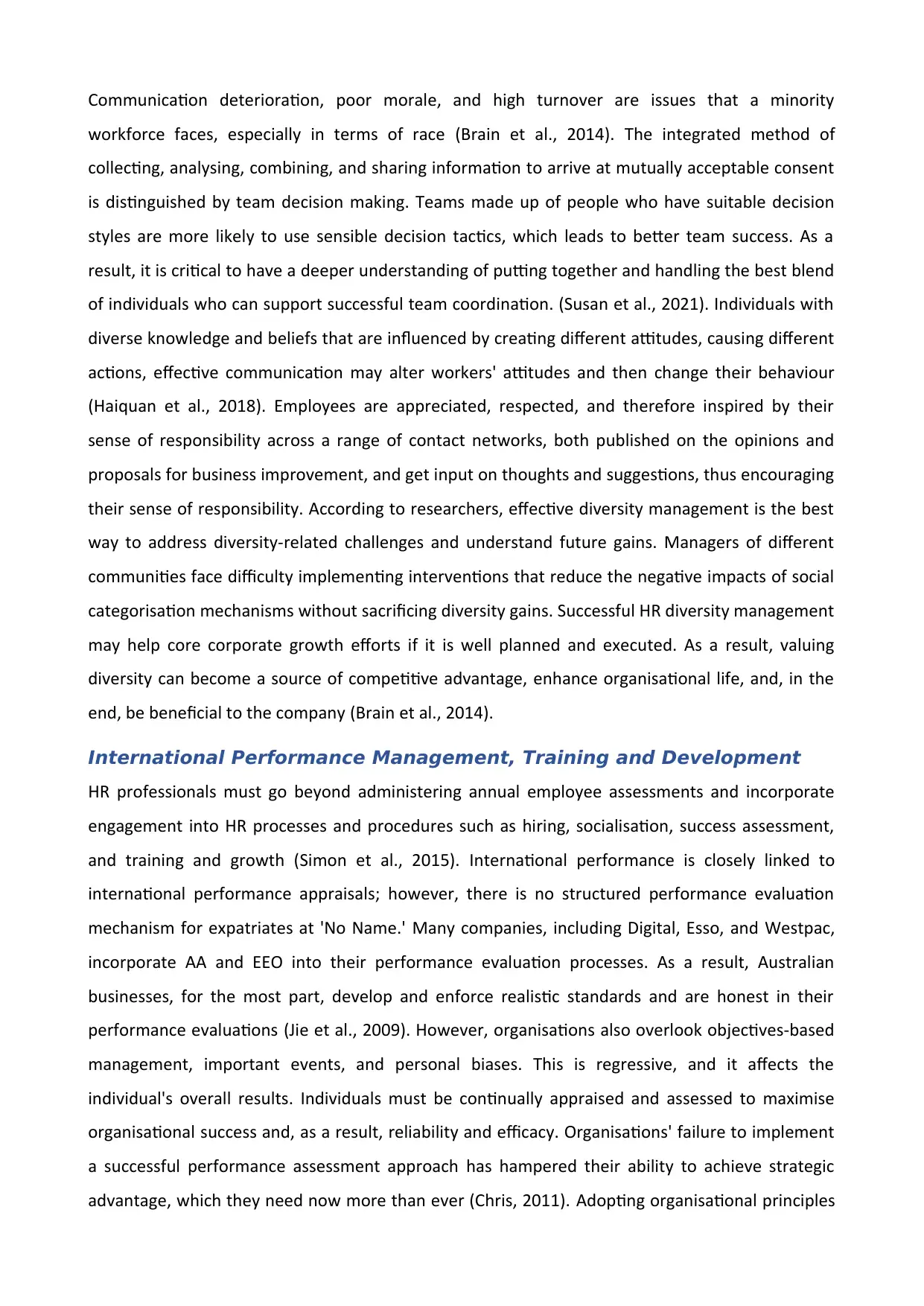
Communication deterioration, poor morale, and high turnover are issues that a minority
workforce faces, especially in terms of race (Brain et al., 2014). The integrated method of
collecting, analysing, combining, and sharing information to arrive at mutually acceptable consent
is distinguished by team decision making. Teams made up of people who have suitable decision
styles are more likely to use sensible decision tactics, which leads to better team success. As a
result, it is critical to have a deeper understanding of putting together and handling the best blend
of individuals who can support successful team coordination. (Susan et al., 2021). Individuals with
diverse knowledge and beliefs that are influenced by creating different attitudes, causing different
actions, effective communication may alter workers' attitudes and then change their behaviour
(Haiquan et al., 2018). Employees are appreciated, respected, and therefore inspired by their
sense of responsibility across a range of contact networks, both published on the opinions and
proposals for business improvement, and get input on thoughts and suggestions, thus encouraging
their sense of responsibility. According to researchers, effective diversity management is the best
way to address diversity-related challenges and understand future gains. Managers of different
communities face difficulty implementing interventions that reduce the negative impacts of social
categorisation mechanisms without sacrificing diversity gains. Successful HR diversity management
may help core corporate growth efforts if it is well planned and executed. As a result, valuing
diversity can become a source of competitive advantage, enhance organisational life, and, in the
end, be beneficial to the company (Brain et al., 2014).
International Performance Management, Training and Development
HR professionals must go beyond administering annual employee assessments and incorporate
engagement into HR processes and procedures such as hiring, socialisation, success assessment,
and training and growth (Simon et al., 2015). International performance is closely linked to
international performance appraisals; however, there is no structured performance evaluation
mechanism for expatriates at 'No Name.' Many companies, including Digital, Esso, and Westpac,
incorporate AA and EEO into their performance evaluation processes. As a result, Australian
businesses, for the most part, develop and enforce realistic standards and are honest in their
performance evaluations (Jie et al., 2009). However, organisations also overlook objectives-based
management, important events, and personal biases. This is regressive, and it affects the
individual's overall results. Individuals must be continually appraised and assessed to maximise
organisational success and, as a result, reliability and efficacy. Organisations' failure to implement
a successful performance assessment approach has hampered their ability to achieve strategic
advantage, which they need now more than ever (Chris, 2011). Adopting organisational principles
workforce faces, especially in terms of race (Brain et al., 2014). The integrated method of
collecting, analysing, combining, and sharing information to arrive at mutually acceptable consent
is distinguished by team decision making. Teams made up of people who have suitable decision
styles are more likely to use sensible decision tactics, which leads to better team success. As a
result, it is critical to have a deeper understanding of putting together and handling the best blend
of individuals who can support successful team coordination. (Susan et al., 2021). Individuals with
diverse knowledge and beliefs that are influenced by creating different attitudes, causing different
actions, effective communication may alter workers' attitudes and then change their behaviour
(Haiquan et al., 2018). Employees are appreciated, respected, and therefore inspired by their
sense of responsibility across a range of contact networks, both published on the opinions and
proposals for business improvement, and get input on thoughts and suggestions, thus encouraging
their sense of responsibility. According to researchers, effective diversity management is the best
way to address diversity-related challenges and understand future gains. Managers of different
communities face difficulty implementing interventions that reduce the negative impacts of social
categorisation mechanisms without sacrificing diversity gains. Successful HR diversity management
may help core corporate growth efforts if it is well planned and executed. As a result, valuing
diversity can become a source of competitive advantage, enhance organisational life, and, in the
end, be beneficial to the company (Brain et al., 2014).
International Performance Management, Training and Development
HR professionals must go beyond administering annual employee assessments and incorporate
engagement into HR processes and procedures such as hiring, socialisation, success assessment,
and training and growth (Simon et al., 2015). International performance is closely linked to
international performance appraisals; however, there is no structured performance evaluation
mechanism for expatriates at 'No Name.' Many companies, including Digital, Esso, and Westpac,
incorporate AA and EEO into their performance evaluation processes. As a result, Australian
businesses, for the most part, develop and enforce realistic standards and are honest in their
performance evaluations (Jie et al., 2009). However, organisations also overlook objectives-based
management, important events, and personal biases. This is regressive, and it affects the
individual's overall results. Individuals must be continually appraised and assessed to maximise
organisational success and, as a result, reliability and efficacy. Organisations' failure to implement
a successful performance assessment approach has hampered their ability to achieve strategic
advantage, which they need now more than ever (Chris, 2011). Adopting organisational principles
Paraphrase This Document
Need a fresh take? Get an instant paraphrase of this document with our AI Paraphraser
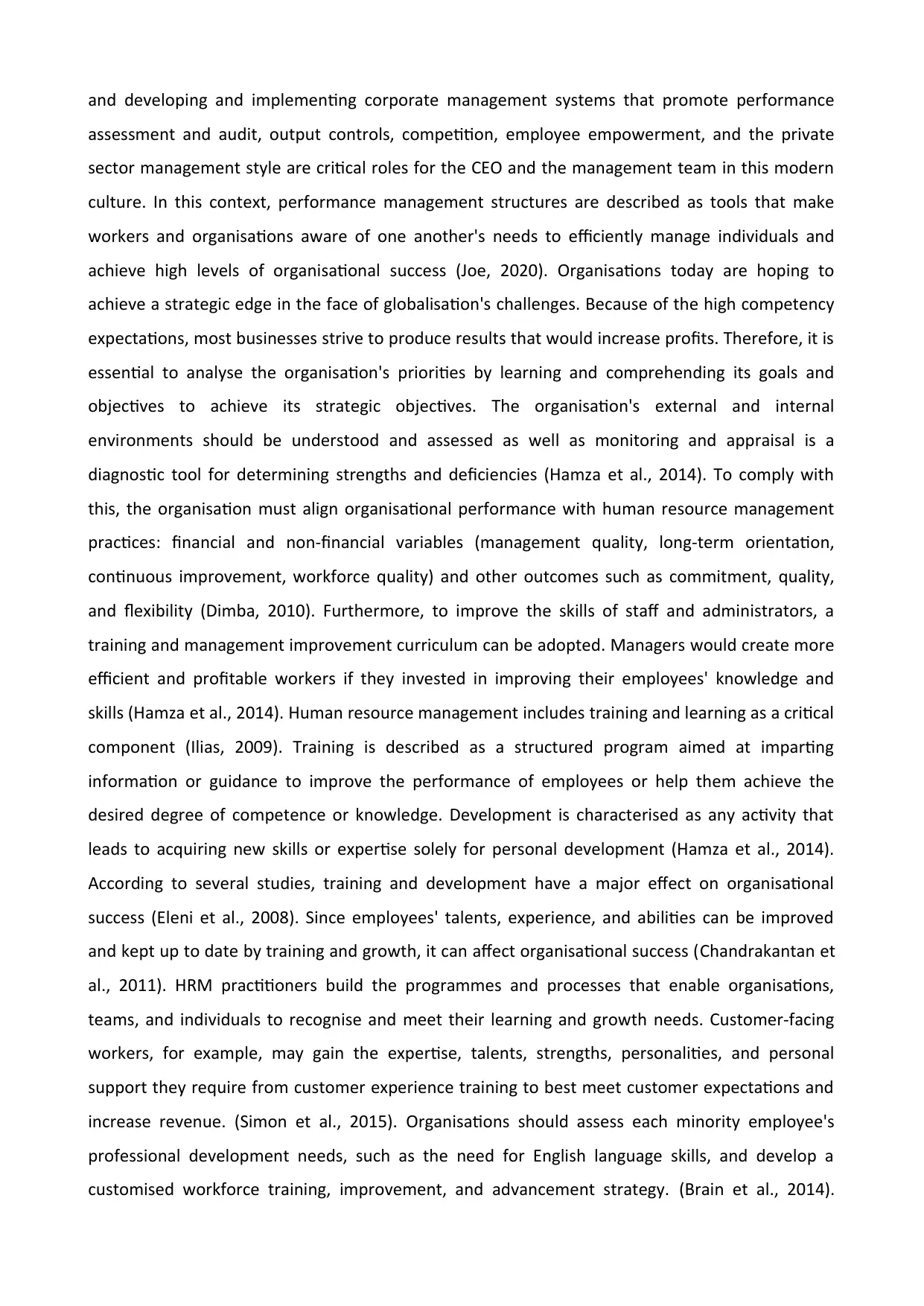
and developing and implementing corporate management systems that promote performance
assessment and audit, output controls, competition, employee empowerment, and the private
sector management style are critical roles for the CEO and the management team in this modern
culture. In this context, performance management structures are described as tools that make
workers and organisations aware of one another's needs to efficiently manage individuals and
achieve high levels of organisational success (Joe, 2020). Organisations today are hoping to
achieve a strategic edge in the face of globalisation's challenges. Because of the high competency
expectations, most businesses strive to produce results that would increase profits. Therefore, it is
essential to analyse the organisation's priorities by learning and comprehending its goals and
objectives to achieve its strategic objectives. The organisation's external and internal
environments should be understood and assessed as well as monitoring and appraisal is a
diagnostic tool for determining strengths and deficiencies (Hamza et al., 2014). To comply with
this, the organisation must align organisational performance with human resource management
practices: financial and non-financial variables (management quality, long-term orientation,
continuous improvement, workforce quality) and other outcomes such as commitment, quality,
and flexibility (Dimba, 2010). Furthermore, to improve the skills of staff and administrators, a
training and management improvement curriculum can be adopted. Managers would create more
efficient and profitable workers if they invested in improving their employees' knowledge and
skills (Hamza et al., 2014). Human resource management includes training and learning as a critical
component (Ilias, 2009). Training is described as a structured program aimed at imparting
information or guidance to improve the performance of employees or help them achieve the
desired degree of competence or knowledge. Development is characterised as any activity that
leads to acquiring new skills or expertise solely for personal development (Hamza et al., 2014).
According to several studies, training and development have a major effect on organisational
success (Eleni et al., 2008). Since employees' talents, experience, and abilities can be improved
and kept up to date by training and growth, it can affect organisational success (Chandrakantan et
al., 2011). HRM practitioners build the programmes and processes that enable organisations,
teams, and individuals to recognise and meet their learning and growth needs. Customer-facing
workers, for example, may gain the expertise, talents, strengths, personalities, and personal
support they require from customer experience training to best meet customer expectations and
increase revenue. (Simon et al., 2015). Organisations should assess each minority employee's
professional development needs, such as the need for English language skills, and develop a
customised workforce training, improvement, and advancement strategy. (Brain et al., 2014).
assessment and audit, output controls, competition, employee empowerment, and the private
sector management style are critical roles for the CEO and the management team in this modern
culture. In this context, performance management structures are described as tools that make
workers and organisations aware of one another's needs to efficiently manage individuals and
achieve high levels of organisational success (Joe, 2020). Organisations today are hoping to
achieve a strategic edge in the face of globalisation's challenges. Because of the high competency
expectations, most businesses strive to produce results that would increase profits. Therefore, it is
essential to analyse the organisation's priorities by learning and comprehending its goals and
objectives to achieve its strategic objectives. The organisation's external and internal
environments should be understood and assessed as well as monitoring and appraisal is a
diagnostic tool for determining strengths and deficiencies (Hamza et al., 2014). To comply with
this, the organisation must align organisational performance with human resource management
practices: financial and non-financial variables (management quality, long-term orientation,
continuous improvement, workforce quality) and other outcomes such as commitment, quality,
and flexibility (Dimba, 2010). Furthermore, to improve the skills of staff and administrators, a
training and management improvement curriculum can be adopted. Managers would create more
efficient and profitable workers if they invested in improving their employees' knowledge and
skills (Hamza et al., 2014). Human resource management includes training and learning as a critical
component (Ilias, 2009). Training is described as a structured program aimed at imparting
information or guidance to improve the performance of employees or help them achieve the
desired degree of competence or knowledge. Development is characterised as any activity that
leads to acquiring new skills or expertise solely for personal development (Hamza et al., 2014).
According to several studies, training and development have a major effect on organisational
success (Eleni et al., 2008). Since employees' talents, experience, and abilities can be improved
and kept up to date by training and growth, it can affect organisational success (Chandrakantan et
al., 2011). HRM practitioners build the programmes and processes that enable organisations,
teams, and individuals to recognise and meet their learning and growth needs. Customer-facing
workers, for example, may gain the expertise, talents, strengths, personalities, and personal
support they require from customer experience training to best meet customer expectations and
increase revenue. (Simon et al., 2015). Organisations should assess each minority employee's
professional development needs, such as the need for English language skills, and develop a
customised workforce training, improvement, and advancement strategy. (Brain et al., 2014).
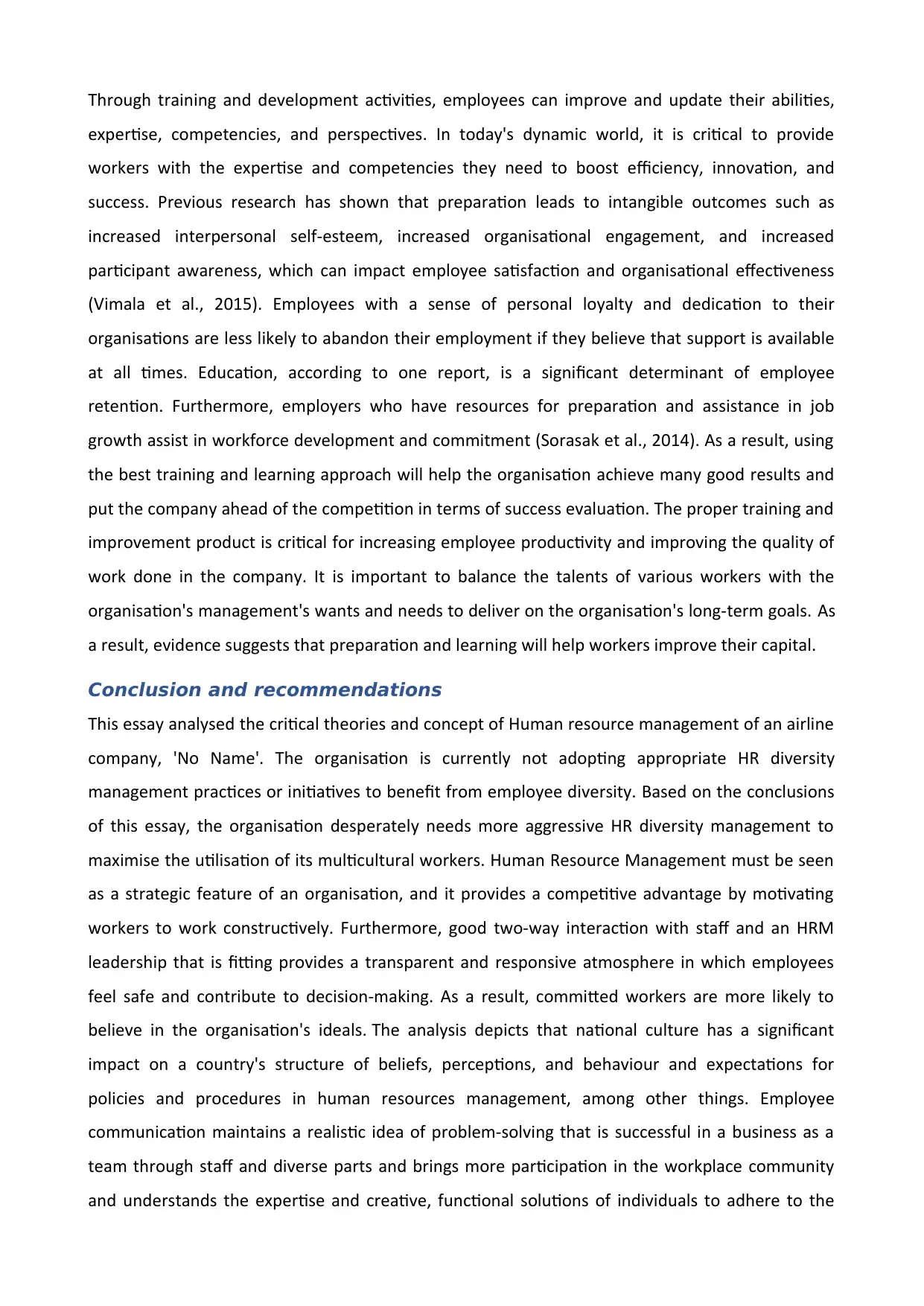
Through training and development activities, employees can improve and update their abilities,
expertise, competencies, and perspectives. In today's dynamic world, it is critical to provide
workers with the expertise and competencies they need to boost efficiency, innovation, and
success. Previous research has shown that preparation leads to intangible outcomes such as
increased interpersonal self-esteem, increased organisational engagement, and increased
participant awareness, which can impact employee satisfaction and organisational effectiveness
(Vimala et al., 2015). Employees with a sense of personal loyalty and dedication to their
organisations are less likely to abandon their employment if they believe that support is available
at all times. Education, according to one report, is a significant determinant of employee
retention. Furthermore, employers who have resources for preparation and assistance in job
growth assist in workforce development and commitment (Sorasak et al., 2014). As a result, using
the best training and learning approach will help the organisation achieve many good results and
put the company ahead of the competition in terms of success evaluation. The proper training and
improvement product is critical for increasing employee productivity and improving the quality of
work done in the company. It is important to balance the talents of various workers with the
organisation's management's wants and needs to deliver on the organisation's long-term goals. As
a result, evidence suggests that preparation and learning will help workers improve their capital.
Conclusion and recommendations
This essay analysed the critical theories and concept of Human resource management of an airline
company, 'No Name'. The organisation is currently not adopting appropriate HR diversity
management practices or initiatives to benefit from employee diversity. Based on the conclusions
of this essay, the organisation desperately needs more aggressive HR diversity management to
maximise the utilisation of its multicultural workers. Human Resource Management must be seen
as a strategic feature of an organisation, and it provides a competitive advantage by motivating
workers to work constructively. Furthermore, good two-way interaction with staff and an HRM
leadership that is fitting provides a transparent and responsive atmosphere in which employees
feel safe and contribute to decision-making. As a result, committed workers are more likely to
believe in the organisation's ideals. The analysis depicts that national culture has a significant
impact on a country's structure of beliefs, perceptions, and behaviour and expectations for
policies and procedures in human resources management, among other things. Employee
communication maintains a realistic idea of problem-solving that is successful in a business as a
team through staff and diverse parts and brings more participation in the workplace community
and understands the expertise and creative, functional solutions of individuals to adhere to the
expertise, competencies, and perspectives. In today's dynamic world, it is critical to provide
workers with the expertise and competencies they need to boost efficiency, innovation, and
success. Previous research has shown that preparation leads to intangible outcomes such as
increased interpersonal self-esteem, increased organisational engagement, and increased
participant awareness, which can impact employee satisfaction and organisational effectiveness
(Vimala et al., 2015). Employees with a sense of personal loyalty and dedication to their
organisations are less likely to abandon their employment if they believe that support is available
at all times. Education, according to one report, is a significant determinant of employee
retention. Furthermore, employers who have resources for preparation and assistance in job
growth assist in workforce development and commitment (Sorasak et al., 2014). As a result, using
the best training and learning approach will help the organisation achieve many good results and
put the company ahead of the competition in terms of success evaluation. The proper training and
improvement product is critical for increasing employee productivity and improving the quality of
work done in the company. It is important to balance the talents of various workers with the
organisation's management's wants and needs to deliver on the organisation's long-term goals. As
a result, evidence suggests that preparation and learning will help workers improve their capital.
Conclusion and recommendations
This essay analysed the critical theories and concept of Human resource management of an airline
company, 'No Name'. The organisation is currently not adopting appropriate HR diversity
management practices or initiatives to benefit from employee diversity. Based on the conclusions
of this essay, the organisation desperately needs more aggressive HR diversity management to
maximise the utilisation of its multicultural workers. Human Resource Management must be seen
as a strategic feature of an organisation, and it provides a competitive advantage by motivating
workers to work constructively. Furthermore, good two-way interaction with staff and an HRM
leadership that is fitting provides a transparent and responsive atmosphere in which employees
feel safe and contribute to decision-making. As a result, committed workers are more likely to
believe in the organisation's ideals. The analysis depicts that national culture has a significant
impact on a country's structure of beliefs, perceptions, and behaviour and expectations for
policies and procedures in human resources management, among other things. Employee
communication maintains a realistic idea of problem-solving that is successful in a business as a
team through staff and diverse parts and brings more participation in the workplace community
and understands the expertise and creative, functional solutions of individuals to adhere to the
⊘ This is a preview!⊘
Do you want full access?
Subscribe today to unlock all pages.

Trusted by 1+ million students worldwide
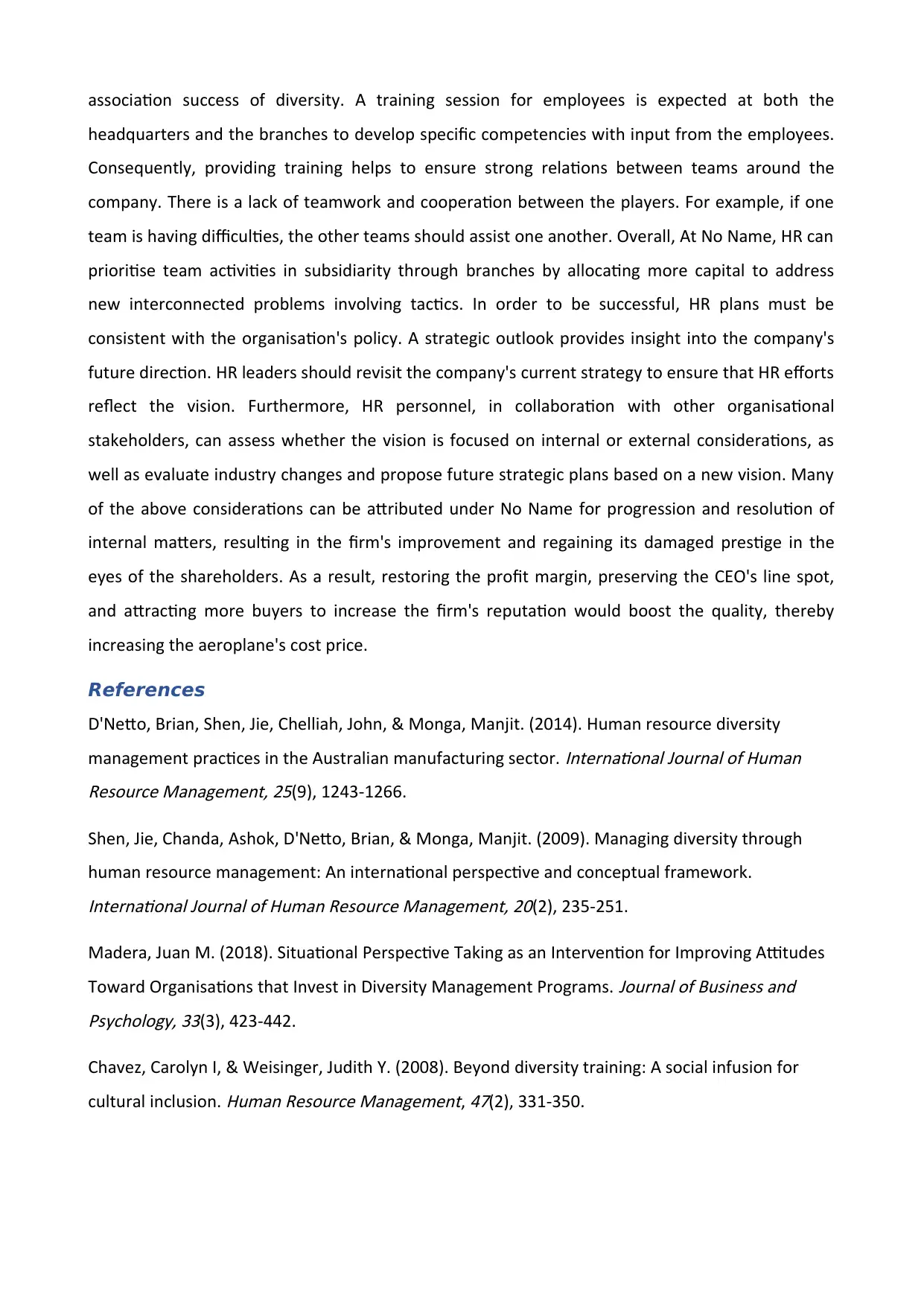
association success of diversity. A training session for employees is expected at both the
headquarters and the branches to develop specific competencies with input from the employees.
Consequently, providing training helps to ensure strong relations between teams around the
company. There is a lack of teamwork and cooperation between the players. For example, if one
team is having difficulties, the other teams should assist one another. Overall, At No Name, HR can
prioritise team activities in subsidiarity through branches by allocating more capital to address
new interconnected problems involving tactics. In order to be successful, HR plans must be
consistent with the organisation's policy. A strategic outlook provides insight into the company's
future direction. HR leaders should revisit the company's current strategy to ensure that HR efforts
reflect the vision. Furthermore, HR personnel, in collaboration with other organisational
stakeholders, can assess whether the vision is focused on internal or external considerations, as
well as evaluate industry changes and propose future strategic plans based on a new vision. Many
of the above considerations can be attributed under No Name for progression and resolution of
internal matters, resulting in the firm's improvement and regaining its damaged prestige in the
eyes of the shareholders. As a result, restoring the profit margin, preserving the CEO's line spot,
and attracting more buyers to increase the firm's reputation would boost the quality, thereby
increasing the aeroplane's cost price.
References
D'Netto, Brian, Shen, Jie, Chelliah, John, & Monga, Manjit. (2014). Human resource diversity
management practices in the Australian manufacturing sector.
International Journal of Human
Resource Management, 25(9), 1243-1266.
Shen, Jie, Chanda, Ashok, D'Netto, Brian, & Monga, Manjit. (2009). Managing diversity through
human resource management: An international perspective and conceptual framework.
International Journal of Human Resource Management, 20(2), 235-251.
Madera, Juan M. (2018). Situational Perspective Taking as an Intervention for Improving Attitudes
Toward Organisations that Invest in Diversity Management Programs.
Journal of Business and
Psychology, 33(3), 423-442.
Chavez, Carolyn I, & Weisinger, Judith Y. (2008). Beyond diversity training: A social infusion for
cultural inclusion.
Human Resource Management,
47(2), 331-350.
headquarters and the branches to develop specific competencies with input from the employees.
Consequently, providing training helps to ensure strong relations between teams around the
company. There is a lack of teamwork and cooperation between the players. For example, if one
team is having difficulties, the other teams should assist one another. Overall, At No Name, HR can
prioritise team activities in subsidiarity through branches by allocating more capital to address
new interconnected problems involving tactics. In order to be successful, HR plans must be
consistent with the organisation's policy. A strategic outlook provides insight into the company's
future direction. HR leaders should revisit the company's current strategy to ensure that HR efforts
reflect the vision. Furthermore, HR personnel, in collaboration with other organisational
stakeholders, can assess whether the vision is focused on internal or external considerations, as
well as evaluate industry changes and propose future strategic plans based on a new vision. Many
of the above considerations can be attributed under No Name for progression and resolution of
internal matters, resulting in the firm's improvement and regaining its damaged prestige in the
eyes of the shareholders. As a result, restoring the profit margin, preserving the CEO's line spot,
and attracting more buyers to increase the firm's reputation would boost the quality, thereby
increasing the aeroplane's cost price.
References
D'Netto, Brian, Shen, Jie, Chelliah, John, & Monga, Manjit. (2014). Human resource diversity
management practices in the Australian manufacturing sector.
International Journal of Human
Resource Management, 25(9), 1243-1266.
Shen, Jie, Chanda, Ashok, D'Netto, Brian, & Monga, Manjit. (2009). Managing diversity through
human resource management: An international perspective and conceptual framework.
International Journal of Human Resource Management, 20(2), 235-251.
Madera, Juan M. (2018). Situational Perspective Taking as an Intervention for Improving Attitudes
Toward Organisations that Invest in Diversity Management Programs.
Journal of Business and
Psychology, 33(3), 423-442.
Chavez, Carolyn I, & Weisinger, Judith Y. (2008). Beyond diversity training: A social infusion for
cultural inclusion.
Human Resource Management,
47(2), 331-350.
Paraphrase This Document
Need a fresh take? Get an instant paraphrase of this document with our AI Paraphraser

Al-Sarayrah, S., Tarhini, A., Obeidat, B. Y., Al-Salti, Z., & Kattoua, T. (2016). The effect of culture on
strategic human resource management practices: A theoretical perspective.
International Journal
of Business Management and Economic Research,
7(4), 704-716.
Buller, P. F., & McEvoy, G. M. (2012). Strategy, human resource management and performance:
Sharpening line of sight.
Human resource management review,
22(1), 43-56.
Đorđević, B. (2016). Impact of national culture on international human resource
management.
Economic Themes,
54(2), 281-300.
Zhu, X. Susan, Wolfson, Mikhail A, Dalal, Dev K, & Mathieu, John E. (2021). Team Decision Making:
The Dynamic Effects of Team Decision Style Composition and Performance via Decision Strategy.
Journal of Management, 47(5), 1281-1304.
Sun, H., Liu, J., & Chen, H. (2018). Communication in Human Resource Management.
Human
Resources Management and Services (TRANSFERRED),
1(1).
Albrecht, S. L., Bakker, A. B., Gruman, J. A., Macey, W. H., & Saks, A. M. (2015). Employee
engagement, human resource management practices and competitive advantage.
Journal of
Organizational Effectiveness: People and Performance.
Obisi, C. (2011). Employee performance appraisal and its implication for individual and
organisational growth.
Australian Journal of Business and Management Research,
1(9), 92.
Christopher, J. (2020). Implementation of performance management in an environment of
conflicting management cultures.
International Journal of Productivity and Performance
Management.
Al-Qudah, M. K. M., Osman, A., Ab Halim, M. S., & Al-Shatanawi, H. A. (2014). The effect of human
resources planning and training and development on organisational performance in the
government sector in Jordan.
International Journal of Academic Research in Business and Social
Sciences,
4(4), 79.
Dimba, B. A. O. (2010). Strategic human resource management practices: effect on
performance.
African journal of economic and management Studies.
Vlachos, I. P. (2009). The effects of human resource practices on firm growth.
International Journal
of Business Science and Applied Management,
4(2), 17-34.
strategic human resource management practices: A theoretical perspective.
International Journal
of Business Management and Economic Research,
7(4), 704-716.
Buller, P. F., & McEvoy, G. M. (2012). Strategy, human resource management and performance:
Sharpening line of sight.
Human resource management review,
22(1), 43-56.
Đorđević, B. (2016). Impact of national culture on international human resource
management.
Economic Themes,
54(2), 281-300.
Zhu, X. Susan, Wolfson, Mikhail A, Dalal, Dev K, & Mathieu, John E. (2021). Team Decision Making:
The Dynamic Effects of Team Decision Style Composition and Performance via Decision Strategy.
Journal of Management, 47(5), 1281-1304.
Sun, H., Liu, J., & Chen, H. (2018). Communication in Human Resource Management.
Human
Resources Management and Services (TRANSFERRED),
1(1).
Albrecht, S. L., Bakker, A. B., Gruman, J. A., Macey, W. H., & Saks, A. M. (2015). Employee
engagement, human resource management practices and competitive advantage.
Journal of
Organizational Effectiveness: People and Performance.
Obisi, C. (2011). Employee performance appraisal and its implication for individual and
organisational growth.
Australian Journal of Business and Management Research,
1(9), 92.
Christopher, J. (2020). Implementation of performance management in an environment of
conflicting management cultures.
International Journal of Productivity and Performance
Management.
Al-Qudah, M. K. M., Osman, A., Ab Halim, M. S., & Al-Shatanawi, H. A. (2014). The effect of human
resources planning and training and development on organisational performance in the
government sector in Jordan.
International Journal of Academic Research in Business and Social
Sciences,
4(4), 79.
Dimba, B. A. O. (2010). Strategic human resource management practices: effect on
performance.
African journal of economic and management Studies.
Vlachos, I. P. (2009). The effects of human resource practices on firm growth.
International Journal
of Business Science and Applied Management,
4(2), 17-34.
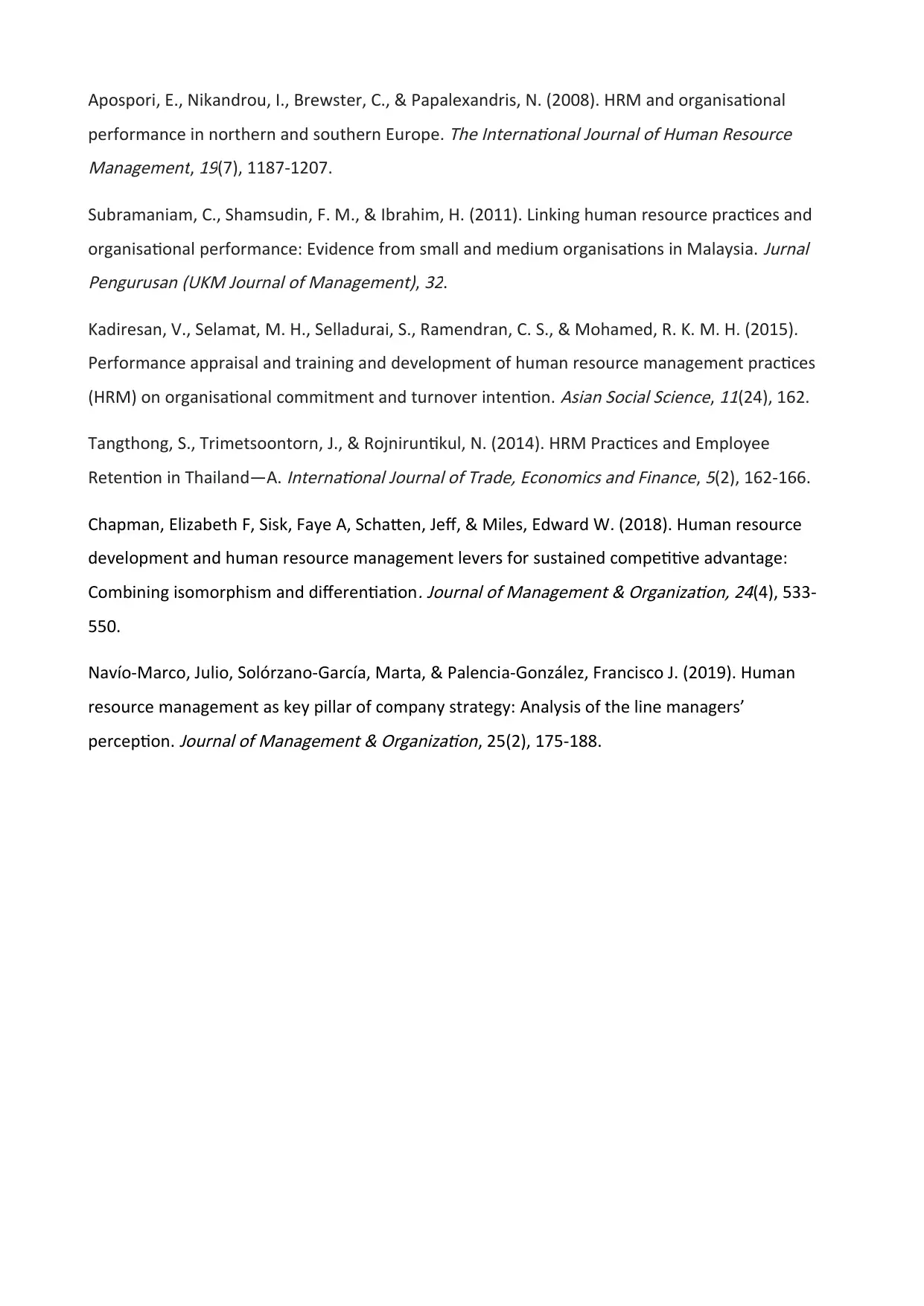
Apospori, E., Nikandrou, I., Brewster, C., & Papalexandris, N. (2008). HRM and organisational
performance in northern and southern Europe.
The International Journal of Human Resource
Management,
19(7), 1187-1207.
Subramaniam, C., Shamsudin, F. M., & Ibrahim, H. (2011). Linking human resource practices and
organisational performance: Evidence from small and medium organisations in Malaysia.
Jurnal
Pengurusan (UKM Journal of Management),
32.
Kadiresan, V., Selamat, M. H., Selladurai, S., Ramendran, C. S., & Mohamed, R. K. M. H. (2015).
Performance appraisal and training and development of human resource management practices
(HRM) on organisational commitment and turnover intention.
Asian Social Science,
11(24), 162.
Tangthong, S., Trimetsoontorn, J., & Rojniruntikul, N. (2014). HRM Practices and Employee
Retention in Thailand—A.
International Journal of Trade, Economics and Finance,
5(2), 162-166.
Chapman, Elizabeth F, Sisk, Faye A, Schatten, Jeff, & Miles, Edward W. (2018). Human resource
development and human resource management levers for sustained competitive advantage:
Combining isomorphism and differentiation
. Journal of Management & Organization, 24(4), 533-
550.
Navío-Marco, Julio, Solórzano-García, Marta, & Palencia-González, Francisco J. (2019). Human
resource management as key pillar of company strategy: Analysis of the line managers’
perception.
Journal of Management & Organization, 25(2), 175-188.
performance in northern and southern Europe.
The International Journal of Human Resource
Management,
19(7), 1187-1207.
Subramaniam, C., Shamsudin, F. M., & Ibrahim, H. (2011). Linking human resource practices and
organisational performance: Evidence from small and medium organisations in Malaysia.
Jurnal
Pengurusan (UKM Journal of Management),
32.
Kadiresan, V., Selamat, M. H., Selladurai, S., Ramendran, C. S., & Mohamed, R. K. M. H. (2015).
Performance appraisal and training and development of human resource management practices
(HRM) on organisational commitment and turnover intention.
Asian Social Science,
11(24), 162.
Tangthong, S., Trimetsoontorn, J., & Rojniruntikul, N. (2014). HRM Practices and Employee
Retention in Thailand—A.
International Journal of Trade, Economics and Finance,
5(2), 162-166.
Chapman, Elizabeth F, Sisk, Faye A, Schatten, Jeff, & Miles, Edward W. (2018). Human resource
development and human resource management levers for sustained competitive advantage:
Combining isomorphism and differentiation
. Journal of Management & Organization, 24(4), 533-
550.
Navío-Marco, Julio, Solórzano-García, Marta, & Palencia-González, Francisco J. (2019). Human
resource management as key pillar of company strategy: Analysis of the line managers’
perception.
Journal of Management & Organization, 25(2), 175-188.
⊘ This is a preview!⊘
Do you want full access?
Subscribe today to unlock all pages.

Trusted by 1+ million students worldwide
1 out of 9
Related Documents
Your All-in-One AI-Powered Toolkit for Academic Success.
+13062052269
info@desklib.com
Available 24*7 on WhatsApp / Email
![[object Object]](/_next/static/media/star-bottom.7253800d.svg)
Unlock your academic potential
Copyright © 2020–2025 A2Z Services. All Rights Reserved. Developed and managed by ZUCOL.





